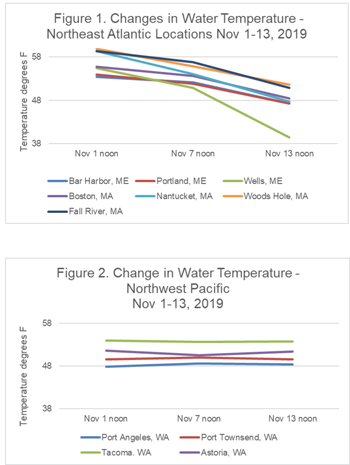Winter is a Comin’ in
by Ann Backus, MS

The title of this article is a paraphrase of a song sung as a round that dates back to 1260: Sumer is icumen in. Music historians say it could be a naïve song about changing seasons or it could have some bawdy overtones. I’ll leave it up to you to figure it out!
In the Northeast we got a rude awakening in the middle of November when an arctic blast swept in and lowered the air temperature suddenly and markedly. I became curious as to what affect this had had on the water temperature. I went to the NOAA tides and currents website https://tidesandcurrents.noaa.gov/ and found some “cool” water temperature data under the tab ‘physical oceanography.’

First, I compared the air temperature change to the water temperature change for seven eastern ports. Using a companion air temperature website, I saw that, during the period November 1 to November 13, the air temperatures ranged from a high 61° F in Boston to a low of 25°F in Portland. At the same time, the water temperatures ranged from a high of roughly 60°F in Woods Hole to a low of 39.4°F in Wells, Maine. This is a high/low spread of 34 degrees in air temperature and high/low spread of slightly over 20 degrees in water temperature in just 13 days. For any single site/port, the drop in water temperature ranged from 6.1 to 16°F. (See Figure 1.)
Next, I compared the range of air and water temperatures in Maine and Massachusetts with the range of air and water temperatures in Washington state. Whereas in the eastern ports, the high/low spread in air temperature was 34 degrees, the spread in the western ports was 11.5 degrees. And whereas in the east, the high/low spread in water temperature was over 20 degrees, the spread in the west was 9 degrees over the 13 days. For any single port in the western state of Washington the change in water temperature ranged from plus 0.6 to minus 0.2. (See Figure 2.) That is not even a full degree change over 13 days.
Where do we go with this information? As those of you who fish the North Atlantic know, our ocean conditions are often harsh – and apparently harsher than those encountered by our fishing colleagues in Washington state – a least according to this small analysis. Air and water temperatures can change rapidly and markedly in the east. We also have a harsher ocean environment that those on the west coast of the UK (England and Ireland) who live at a more northern latitude than we do. (Bar Harbor 44°N vs London 51°N.)
Our waters are cooled by the Labrador Current that flows from Greenland past Newfoundland and Nova Scotia to our northern-most east coast states. Waters near the UK and Ireland are warmed by the Gulf Stream extension known as the North Atlantic Current.
Implications
These abrupt changes in our air and water temperatures, and the realization that we are entering a period of harsh weather for the next four months should prompt us to do some checking and some shopping (or at least put some items on a holiday wish list). Check that your immersion suit still fits—try it on—and that the fabric still has integrity—no weak spots. Grease the zipper with synthetic wax or bees wax—not vaseline or other petroleum product. Replace the crumbly, deteriorating plastic bags if you use them to help you slide your feet into the suit. Again, practice getting into your suit and see if you can do it in under a minute.
Check and/or test all the safety equipment such as EPIRBs, life raft, flares, throw rings, fire extinguishers, navigation lights, VHF radio, bilge alarms, pumps, and weather monitoring equipment. Check out the Northeast Center’s website http://www.necenter.org/fishing/research/?id=28 and their Face Book page https://www.facebook.com/LifejacketsforLobstermen where you can find information about PFDs. The culture around wearing PFDs has changed markedly over the last several years; if you were not one of the over 1030 fishermen who purchased a PFD during the NEC’s Lifejackets for Lobstermen project (April-November 2019), it is time to go shopping and get yours. But don’t buy one just to be cool, buy it to increase your chances of being rescued.
If you need more convincing, please read “The 1-10-1 Rule and the Importance of the PFD in Surviving Cold Water Immersion” (Fishermen’s Voice, October 2019, Volume 24 Number 10). Winter is a comin’ in. We want you to survive it.
Ann Backus, MS is an Instructor in Occupational Health at Harvard School of Public Health, 665 Huntington Ave., Boston MA 02 5, 617-432-3327, abackus@hohp.harvard.edu.
